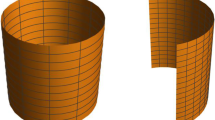Abstract
The problem of the decomposition of an axisymmetric body of revolution in an ionized airstteam is formulated and solved numerically. Equations are presented for numerical calculation of the diffusional fluxes for generalized Schmidt numbers for the case of ambipolar diffusion in a multicomponent partially ionized mixture with ions of various sorts which differ in mass and charge. For materials consisting of the elements H, C, N, and O we discuss the kinetic decomposition condition, which is used to close the system of boundary conditions, in the form of the dependence of the linear decomposition rate on the surface temperature, gas pressure, and body dimensions. As an example we calculate the decomposition of a sphere made from a material which is similar in properties to textolite in an airstream with stagnation temperature of 14 000° K. It is found that the distribution of the decomposition rate over the sphere surface is nearly independent of the type of material and freestream parameters and coincides to within 10 percent with the distribution of the thermal fluxes to the nondecomposed body. We study a generalized analogy for the mass transfer coefficients in the vicinity of the forward stagnation point.
Similar content being viewed by others
References
L. G. Loitsyanskii, The Laminar Boundary Layer [in Russian], Fizmatgiz, Moscow, 1962.
J. D. Hirschfelder, C. F. Curtiss, and R. B. Bird, Molecular Theory of Gases and Liquids [Russian translation], Izd-vo inostr. lit., Moscow, 1961.
G. A. Tirskii, “Conditions at strong discontinuity surfaces in multicomponent mixtures”, PMM, vol. 25, no. 2, 1961.
S. M. Scala and L. M. Gilbert, “Sublimation of graphite at hypersonic speeds”, AIAA Journal, vol. 3, no. 9, 1965.
J. W. Metzger, M. J. Engel, and N. S. Diaconis, “Oxidation and sublimation of graphite in simulated re-entry environments”, AIAA Journal, vol. 5, no. 3, 1967.
P'eng Tsai-Ch'eng and Pindroch, “Improved calculation of air properties at high temperatures”, Voprosy raketnoi tekhniki, no. 12, 1962.
R. A. Swehla, “Estimated viscosities and thermal conductivities of gases at high temperatures”, NASA TR, R-132, 1962.
H. S. W. Massey and E. H. S. Burhop, Electronic and Ionic Impact Phenomena [Russian translation], Izd-vo inostr. lit., Moscow, 1958.
J. A. Fay and N. H. Kemp, “Theory of heat transfer to a shock-tube end-wall from an ionized nonatomic gas”, J. Fluid Mech., vol. 21, pt. 4, 1965.
N. A. Anfimov, “Laminar boundary layer on a chemically active surface”, Izv. AN SSSR, OTN, Mekhanika i mashinostroenie, no. 3, 1962.
V. M. Ovsyannikov, “Decomposition of an axisymmetric body of revolution made from material of complex chemical composition in a high-enthalpy air stream”, Izv. AN SSSR, MZhG [Fluid Dynamics], no. 5, 1967.
O. M. Belotserkovskii, Calculation of Axisymmetric Body Flow with Detached Shock [in Russian], VTs AN SSSR, Moscow, 1961.
V. K. Dushin, “Application of the method of characteristics to calculate supersonic external gas flows with nonequilibrium processes”, collection: Numerical Methods for Solving Problems of Mathematical Physics [in Russian], Nauka, Moscow, 1966.
I. V. Petukhov, “Numerical calculation of two-dimensional boundary layer flows”, collection: Numerical Methods for Solving Differential and Integral Equations and Quadrature Formulas [in Russian], Nauka, Moscow, 1964.
G. A. Tirskii, “Determining the effective diffusion coefficients in a laminar multicomponent boundary layer”, DAN SSSR, vol. 155, no. 6, 1964.
B. V. Alekseev, “Calculation of the boundary layer with chemical reactions along the generators of bodies of revolution”, Zh. vychisl. matem. i matem. fiz., vol. 7, no. 4, 1967.
Author information
Authors and Affiliations
Additional information
In conclusion the authors wish to thank O. N. Suslov for numerous valuable comments.
Rights and permissions
About this article
Cite this article
Ovsyannikov, V.M., Tirskii, G.A. Decomposition of an axisymmetric body of revolution made of a material of complex chemical composition in a partially ionized airstream. Fluid Dyn 3, 66–72 (1968). https://doi.org/10.1007/BF01029539
Issue Date:
DOI: https://doi.org/10.1007/BF01029539



